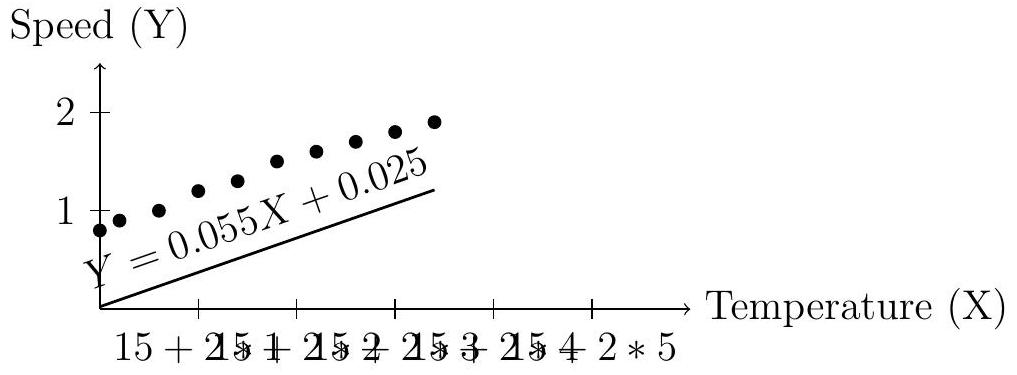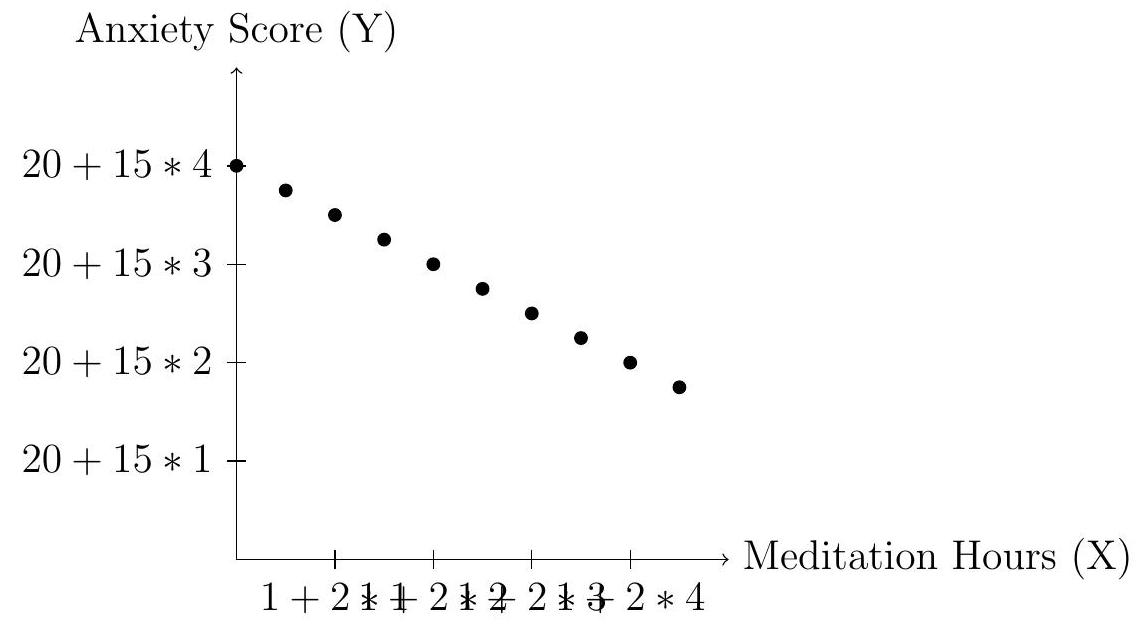- IB
- AHL 4.12—Data collection, reliability and validity tests
Practice AHL 4.12—Data collection, reliability and validity tests with authentic IB Mathematics Applications & Interpretation (AI) exam questions for both SL and HL students. This question bank mirrors Paper 1, 2, 3 structure, covering key topics like core principles, advanced applications, and practical problem-solving. Get instant solutions, detailed explanations, and build exam confidence with questions in the style of IB examiners.
A marine biologist, Raj, investigates whether water temperature ( ) affects the swimming speed (m/s) of a fish species. He observes 10 fish in controlled tanks and records:
| Fish | Temperature (X) | Speed (Y) |
|---|---|---|
| 1 | 15 | 0.8 |
| 2 | 16 | 0.9 |
| 3 | 18 | 1.0 |
| 4 | 20 | 1.2 |
| 5 | 22 | 1.3 |
| 6 | 24 | 1.5 |
| 7 | 26 | 1.6 |
| 8 | 28 | 1.7 |
| 9 | 30 | 1.8 |
| 10 | 32 | 1.9 |
Raj assumes a linear model and tests if the sample mean temperature aligns with an ocean average of . He also checks if speeds are normally distributed.
Name a test to verify normality of swimming speeds.
Calculate the correlation coefficient, .
Conduct a one-tailed test at the significance level for positive correlation. State hypotheses and conclusion.
(i) Find the linear regression equation. (ii) Predict the speed at .
Test if the sample mean temperature differs from at the significance level. State hypotheses and conclusion.
Suggest one way to improve the validity of Raj's study.

A nutritionist, Clara, investigates whether daily fiber intake (grams) influences energy levels in adults. She surveys 15 adults, recording their fiber intake and energy scores (out of 100) based on a standardized questionnaire. The data is:
| Adult | Fiber Intake (X) | Energy Score (Y) |
|---|---|---|
| 1 | 10 | 60 |
| 2 | 12 | 62 |
| 3 | 15 | 65 |
| 4 | 18 | 68 |
| 5 | 20 | 70 |
| 6 | 22 | 72 |
| 7 | 25 | 75 |
| 8 | 28 | 78 |
| 9 | 30 | 80 |
| 10 | 32 | 82 |
| 11 | 35 | 85 |
| 12 | 38 | 88 |
| 13 | 40 | 90 |
| 14 | 42 | 92 |
| 15 | 45 | 95 |
Clara assumes a linear model and tests if the sample mean fiber intake aligns with a population mean of 25 grams. She also checks for normality of energy scores.
Name a test to verify if energy scores are normally distributed.
Calculate Pearson's correlation coefficient, .
Conduct a one-tailed test at the significance level to determine if fiber intake positively correlates with energy scores. State hypotheses and conclusion.
(i) Find the linear regression coefficients and . (ii) Predict the energy score for a fiber intake of 27 grams.
Test if the sample mean fiber intake differs from 25 grams at the significance level. State the test, hypotheses, and conclusion.
Suggest one method to improve the reliability of Clara's study.
A researcher, Omar, studies whether the number of hours spent on meditation per week affects anxiety levels in employees. He collects data from 10 employees:
| Employee | Meditation Hours (X) | Anxiety Score (Y) |
|---|---|---|
| 1 | 1 | 80 |
| 2 | 2 | 75 |
| 3 | 3 | 70 |
| 4 | 4 | 65 |
| 5 | 5 | 60 |
| 6 | 6 | 55 |
| 7 | 7 | 50 |
| 8 | 8 | 45 |
| 9 | 9 | 40 |
| 10 | 10 | 35 |
Omar assumes a linear model and tests if the sample mean meditation hours align with a company average of 5 hours.
Define what is meant by a criterion-related validity test in this context.
Calculate the correlation coefficient, .
Justify whether meditation hours are a valid predictor of anxiety levels.
(i) Find the linear regression equation. (ii) Interpret in context.
Test if the sample mean meditation hours differ from 5 hours at the significance level. State hypotheses and conclusion.

A farmer claims defective apples in crates of 10 follow . She inspects 100 crates:
| Defective Apples | Crates |
|---|---|
| 0 | 20 |
| 1 | 35 |
| 2 | 25 |
| 3 | 15 |
| 4 | 5 |
Estimate .
Test at significance if the data follows . State hypotheses, expected frequencies, and conclusion.
A dairy farmer, Sofia, believes the number of defective milk bottles in a batch of 10 follows a binomial distribution . She inspects 80 batches:
| Defective Bottles | Batches |
|---|---|
| 0 | 25 |
| 1 | 30 |
| 2 | 20 |
| 3 | 5 |
Calculate the mean number of defective bottles and estimate .
Conduct a chi-squared test at the significance level to verify the binomial distribution. State hypotheses, expected frequencies, and conclusion.
Explain why combining categories may be necessary in this test.
Without further calculations, describe how to test for with unspecified .
A forester, Mia, hypothesizes that the diameters (cm) of trees in a forest follow a normal distribution. She measures 150 trees, with summary statistics: 141750. The data is grouped:
| Diameter | Frequency |
|---|---|
| 10 | |
| 35 | |
| 50 | |
| 40 | |
| 15 |
Calculate unbiased estimates of the population mean and variance.
State hypotheses for a chi-squared goodness of fit test.
Calculate expected frequencies for the normal distribution and the chi-squared statistic. Conclude at the significance level.
Describe the purpose of a goodness of fit test in this context.
Emma examines if daily water intake (liters) affects cognitive performance in office workers. She collects data from 10 workers:
| Worker | Water Intake (X) | Cognitive Score (Y) |
|---|---|---|
| 1 | 1.0 | 60 |
| 2 | 1.5 | 65 |
| 3 | 2.0 | 70 |
| 4 | 2.5 | 75 |
| 5 | 3.0 | 80 |
| 6 | 3.5 | 85 |
| 7 | 4.0 | 88 |
| 8 | 4.5 | 90 |
| 9 | 5.0 | 92 |
| 10 | 5.5 | 94 |
Emma uses a linear model and tests if the sample mean water intake matches a population mean of 2.5 liters. She checks normality of cognitive scores.
Name a test for normality of cognitive scores.
Calculate .
Test at significance for positive correlation between water intake and cognitive scores. State hypotheses and conclusion.
(i) Find the linear regression equation. (ii) Predict the cognitive score for 3.2 liters.
Test if the sample mean water intake differs from 2.5 liters at significance.
A botanist, Elena, studies whether the daily sunlight exposure (hours) of a certain plant species affects its growth rate (cm per week). She randomly selects 12 plants and records their sunlight exposure and growth rate. The data is:
| Plant | Sunlight Hours (X) | Growth Rate (Y) |
|---|---|---|
| 1 | 4.0 | 1.2 |
| 2 | 4.5 | 1.3 |
| 3 | 5.0 | 1.5 |
| 4 | 5.5 | 1.6 |
| 5 | 6.0 | 1.8 |
| 6 | 6.5 | 2.0 |
| 7 | 7.0 | 2.1 |
| 8 | 7.5 | 2.3 |
| 9 | 8.0 | 2.4 |
| 10 | 8.5 | 2.6 |
| 11 | 9.0 | 2.7 |
| 12 | 9.5 | 2.8 |
Elena assumes a linear model and tests whether the sample mean sunlight hours align with a regional average of 6.5 hours.
Define what is meant by a criterion-related validity test in this context.
Calculate Pearson's correlation coefficient, .
Determine, with justification, whether sunlight hours are a valid predictor of growth rate.
(i) Find the coefficients and . (ii) Interpret the meaning of in context.
Conduct a -test at the significance level to determine if the sample mean sunlight hours differ from 6.5 hours. State hypotheses and conclusion.
A farmer, Aisha, claims that the number of defective tomatoes in a basket of 8 follows a binomial distribution . She inspects 120 baskets and records:
| Defective Tomatoes | Baskets |
|---|---|
| 0 | 30 |
| 1 | 40 |
| 2 | 30 |
| 3 | 15 |
| 4 | 5 |
Calculate the mean number of defective tomatoes per basket and estimate .
Conduct a chi-squared test at the significance level to verify the binomial distribution claim. State hypotheses, expected frequencies, and conclusion.
Explain why combining categories might be necessary in the chi-squared test.
Noah studies if biology study hours affect exam scores for 10 students:
| Student | Study Hours (X) | Exam Score (Y) |
|---|---|---|
| 1 | 5 | 60 |
| 2 | 7 | 65 |
| 3 | 10 | 70 |
| 4 | 12 | 75 |
| 5 | 15 | 80 |
| 6 | 18 | 85 |
| 7 | 20 | 88 |
| 8 | 22 | 90 |
| 9 | 25 | 92 |
| 10 | 30 | 95 |
Noah tests if study hours predict scores and if the sample mean study hours match a population mean of 15 hours.
Name the validity test type.
Calculate .
Justify if study hours predict scores.
Find the linear regression equation.
Test if the sample mean study hours differ from 15 hours at significance.